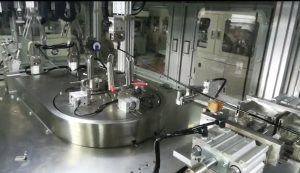The precise processing of medical tubing is paramount in the manufacturing of reliable medical devices. Ensuring accurate cut lengths and consistent coiling is critical for applications ranging from fluid delivery systems to catheter assemblies. This automated machine addresses these demanding requirements, offering a high-efficiency solution for cutting medical-grade tubing to precise lengths and subsequently coiling it for packaging or further processing.

Engineered for precision and throughput, this system integrates advanced automation technologies to streamline production workflows, minimize manual handling, and enhance overall product quality in compliance with stringent medical manufacturing standards.
1. Addressing Precision Needs in Medical Device Manufacturing
The medical industry demands exceptional accuracy. Variations in tubing length or improper coiling can compromise device function and patient safety. This machine is designed to meet sub-millimeter cutting tolerances and produce neatly wound coils, eliminating inconsistencies often associated with manual or semi-automated processes.
2. Core Functionality: Cutting and Coiling Explained
The machine operates through a synchronized sequence:
- Tube Feeding: A precision feeding mechanism, often driven by servo motors, carefully draws the tubing from a source spool or container, ensuring consistent tension and preventing material deformation.
- Length Measurement: Sophisticated sensors or encoders accurately measure the tubing as it advances, guaranteeing the desired length is achieved before cutting.
- Precision Cutting: A high-speed, non-contaminating cutting mechanism (e.g., rotary blade, shear cut) executes a clean, burr-free cut at the programmed length. Blade material and design are critical for handling various medical polymers.
- Automated Coiling: Post-cutting, the tube segment is transferred to a coiling station. The system winds the tube into a uniform coil of specified inner and outer diameter, often incorporating automated binding or securing mechanisms for coil integrity.
3. Key Technical Specifications and Design Features
While specific configurations may vary, typical performance parameters for such equipment include:
- Tubing Material Compatibility: Silicone, PVC, PU, TPE, Pebax, and other common medical-grade polymers.
- Tubing Diameter Range: Typically handles diameters from 1mm up to 15mm (model dependent).
- Cutting Length Range: Programmable from a few centimeters up to several meters.
- Cutting Accuracy/Tolerance: Often achieves ±0.1mm to ±0.5mm, depending on material and length.
- Coiling Inner Diameter (ID): Adjustable, e.g., 50mm - 200mm.
- Coiling Outer Diameter (OD): Adjustable, e.g., up to 350mm.
- Maximum Production Speed: Variable, often capable of processing 10-30 pieces per minute (depending on length and coiling complexity).
- Control System: PLC (Programmable Logic Controller) with intuitive HMI (Human-Machine Interface) touchscreen.
- Drive System: High-precision Servo motors for feeding and coiling actions.
- Construction: Stainless steel contact parts and robust frame suitable for cleanroom or near-cleanroom environments.
4. Component Breakdown: Ensuring Reliability and Performance
The machine's reliability hinges on the quality of its core components:
- Servo Drive System: Provides the high accuracy and repeatability needed for consistent length feeding and controlled coiling tension.
- PLC & HMI: Allows for easy programming of parameters (length, quantity, coil dimensions), recipe storage, diagnostics, and operational monitoring.
- Cutting Blade Assembly: Engineered for longevity and clean cuts specific to medical polymers, minimizing particulate generation.
- Precision Rollers/Feeders: Designed to handle delicate tubing without crushing or marking.
- Sensors: Optical or mechanical sensors for precise length measurement and process control interlocks.
- Coiling Mandrel & Mechanism: Robust design for consistent coil formation and automatic ejection/binding.
5. Operational Workflow and User Experience
Designed for ease of use, the typical workflow involves:
- Loading the source tubing onto the machine's payoff system.
- Feeding the tubing through the guiding, measuring, and cutting stations.
- Using the HMI touchscreen to input desired parameters: cut length, batch quantity, coiling specifications (ID/OD), and machine speed.
- Initiating the automatic cycle. The machine runs continuously, cutting and coiling tubes until the batch quantity is met.
- Operators monitor the process and collect the finished, coiled tubes. Alarms and diagnostics on the HMI alert users to any potential issues (e.g., material run-out).
6. Material Compatibility and Application Versatility
This automated system demonstrates versatility by processing a wide array of medical-grade tubing materials crucial for:
- IV administration sets
- Catheter tubing
- Drainage tubes
- Dialysis tubing
- Respiratory therapy circuits
- Peristaltic pump tubing
The ability to precisely cut and coil these different materials makes the machine a valuable asset across various medical device manufacturing sectors.
7. Benefits of Automation in Medical Tubing Processing
Implementing this automated solution yields significant advantages:
- Enhanced Precision & Consistency: Eliminates human error associated with manual cutting and coiling.
- Increased Throughput: Significantly faster than manual methods, boosting production capacity.
- Reduced Labor Costs: Frees up personnel for more complex tasks.
- Minimized Material Waste: Accurate cutting reduces scrap generated from length errors.
- Improved Cleanliness: Automated handling reduces potential contamination risks.
- Process Traceability: PLC systems can often log production data for quality control and validation purposes.
8. Considering Integration and Validation
For medical device manufacturers, equipment validation (IQ/OQ/PQ) is essential. This machine is typically designed with validation in mind, utilizing materials and control systems that facilitate this process. Furthermore, its automated nature allows for potential integration into larger production lines or work cells, communicating with upstream and downstream equipment for seamless manufacturing flow.
9. Conclusion: Advancing Medical Manufacturing Efficiency
The Automatic Medical Tubing Cutting to Size and Coiling Machine represents a significant advancement in medical device manufacturing technology. By combining precision mechanics, sophisticated controls, and automated handling, it delivers unparalleled accuracy, efficiency, and reliability in processing critical tubing components. This investment helps manufacturers meet stringent quality standards, improve productivity, and ultimately contribute to the production of safer and more effective medical devices. For companies looking to optimize their tubing preparation processes, exploring such automated solutions is a crucial step towards operational excellence.

